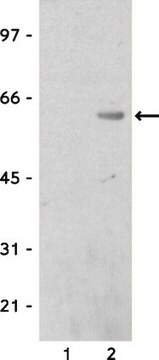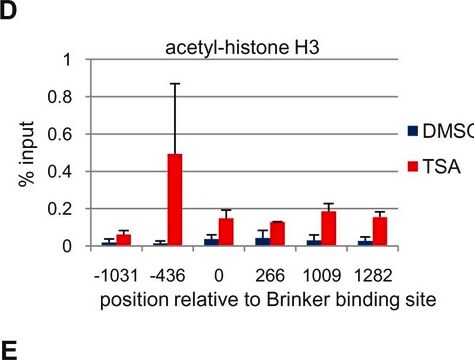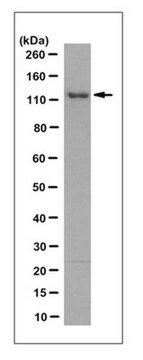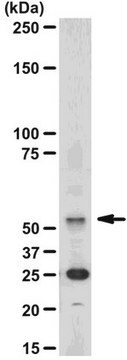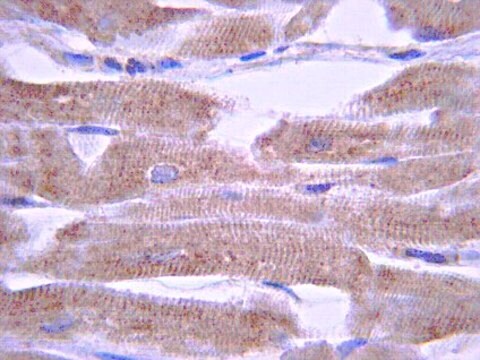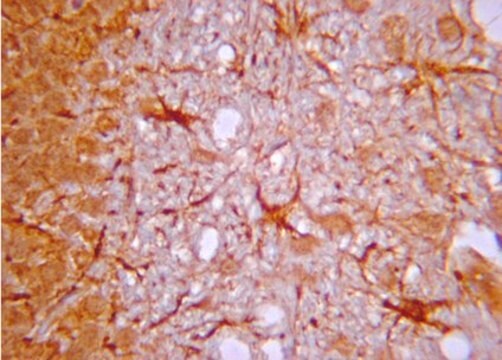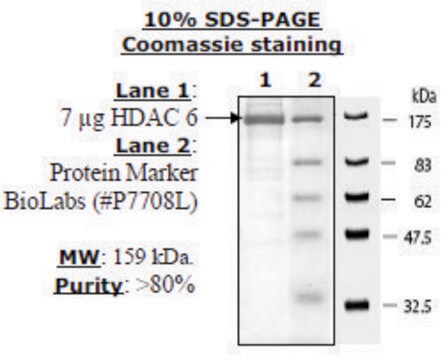05-932
Anti-Calmodulin Binding Protein Epitope Tag Antibody, clone C16T, rabbit monoclonal
clone C16T, Upstate®, from rabbit
Sign Into View Organizational & Contract Pricing
All Photos(1)
About This Item
UNSPSC Code:
12352203
eCl@ss:
32160702
NACRES:
NA.41
Recommended Products
biological source
rabbit
Quality Level
antibody form
purified immunoglobulin
antibody product type
primary antibodies
clone
C16T, monoclonal
species reactivity
vertebrates
manufacturer/tradename
Upstate®
technique(s)
western blot: suitable
isotype
IgG
shipped in
dry ice
target post-translational modification
unmodified
Gene Information
human ... CALM1(801)
Specificity
Recombinant proteins containing the calmodulin binding protein epitope tag.
Immunogen
KLH-conjugated, synthetic peptide corresponding to the Calmodulin Binding Protein (CBP) epitope tag found in several E. coli expression vectors
Application
Anti-Calmodulin Binding Protein Epitope Tag Antibody, clone C16T is an antibody against Calmodulin Binding Protein Epitope Tag for use in WB.
Research Category
Epitope Tags & General Use
Epitope Tags & General Use
Research Sub Category
Epitope Tags
Epitope Tags
Quality
Routinely evaluated by immunoblot on E. coli transformed with a plasmid encoding a calmodulin binding protein epitope tagged protein
Target description
The molecular weight is related to the tagged protein.
Physical form
Format: Purified
Protein A Purified immunoglobulin in 30% glycerol, 0.07M Tris-glycine, pH 7.4, 0.105 M NaCl, 0.035% sodium azide as a preservative.
Protein A purified
Storage and Stability
Maintain for 2 years at -20°C from date of shipment. Aliquot to avoid repeated freezing and thawing. For maximum recovery of product, centrifuge the original vial after thawing and prior to removing the cap.
Analysis Note
Control
Samples containing the calmodulin binding protein epitope tag.
Samples containing the calmodulin binding protein epitope tag.
Other Notes
Concentration: Please refer to the Certificate of Analysis for the lot-specific concentration.
Legal Information
UPSTATE is a registered trademark of Merck KGaA, Darmstadt, Germany
Disclaimer
Unless otherwise stated in our catalog or other company documentation accompanying the product(s), our products are intended for research use only and are not to be used for any other purpose, which includes but is not limited to, unauthorized commercial uses, in vitro diagnostic uses, ex vivo or in vivo therapeutic uses or any type of consumption or application to humans or animals.
Not finding the right product?
Try our Product Selector Tool.
Storage Class Code
10 - Combustible liquids
WGK
WGK 1
Certificates of Analysis (COA)
Search for Certificates of Analysis (COA) by entering the products Lot/Batch Number. Lot and Batch Numbers can be found on a product’s label following the words ‘Lot’ or ‘Batch’.
Already Own This Product?
Find documentation for the products that you have recently purchased in the Document Library.
Affinity purification of histidine-tagged proteins.
Schmitt, J, et al.
Molecular Biology Reports, 18, 223-230 (1993)
A B Vojtek et al.
Cell, 74(1), 205-214 (1993-07-16)
We have identified proteins that interact with H-Ras using a two hybrid system screen of a mouse cDNA library. Approximately 50% of the clones identified encoded portions of the c-Raf and A-Raf serine/threonine kinases. Overlaps among these clones define a
D W Carr et al.
The Journal of biological chemistry, 266(22), 14188-14192 (1991-08-05)
The type II cAMP-dependent protein kinase is localized to specific subcellular environments through the binding of the regulatory subunit (RII) dimer to RII-anchoring proteins. Computer-aided analysis of secondary structure, performed on four RII-anchoring protein sequences (the microtubule-associated protein 2, P150
Strategies for the identification of interacting proteins.
Guarente, L
Proceedings of the National Academy of Sciences of the USA, 90, 1639-1641 (1993)
A single step purification for recombinant proteins. Characterization of a microtubule associated protein (MAP 2) fragment which associates with the type II cAMP-dependent protein kinase.
Stofko-Hahn, R E, et al.
Febs Letters, 302, 274-278 (1992)
Our team of scientists has experience in all areas of research including Life Science, Material Science, Chemical Synthesis, Chromatography, Analytical and many others.
Contact Technical Service